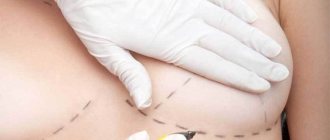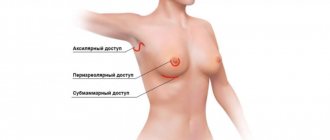When is revision mammoplasty required?
Secondary breast surgery is performed to correct the results of the first intervention or eliminate mistakes. In addition to individual postoperative complications, the reason for secondary correction can be incorrectly selected or low-quality implants. Dissatisfaction with the final result is another reason for subsequent surgery.
Sometimes planned correction of the mammary glands is performed. Repeated plastic surgery can be planned already at the stage of the first operation. This is true in cases where breast volume changes radically. Installing implants of the desired size during the first operation is impossible, as they will cause a sharp load on the spine and lead to overstretching of the soft tissues.
Pre-planned (planned) surgery
All women seeking to significantly increase breast volume are advised to move towards their goal in stages - at each stage, choosing implants slightly larger than the previous ones for installation. In such cases, repeat mammoplasty is mandatory and is planned in advance. Moreover, this may not even be one, but several operations.
Many patients are very worried before surgery, believing that the need for repeat mammoplasty may be caused by the unsatisfactory quality of the implants or their expiration date. However, in this case there is no reason to worry: modern implants are made exclusively from high-tech, fully biocompatible materials, and therefore have a lifetime guarantee.
Differences from primary mammoplasty
The second operation has a main feature: increased risks. Unlike the first procedure, the likelihood of complications is higher. There is a possibility of formation of adhesions, scars, and a tissue capsule around the silicone, so the correction is carried out in several stages. During the initial operation, the patient’s wishes regarding the location of the endoprosthesis are taken into account. During correction, the placement of the implant is influenced by the condition of the tissues and the presence of complications. Another distinctive feature of the second adjustment is the lack of soft tissue for silicone coating. In this case, you have to resort to breast lipofilling.
Indications
Indications for breast replacement can be medical and aesthetic.
Medical:
- damage due to trauma to the implant shell;
- displacement or palpation of the silicone insert;
- the formation of tissue adhesions around the implant, as a result of which the tissue “capsule” compresses the silicone and causes discomfort;
- deformation or asymmetry of the breast as a result of an unsuccessful previous operation;
- change in the position of the areola.
The reason for correction may be aesthetic indicators:
- the patient’s desire to change the size of the breast or implant;
- the desire to change the shape of the breast and use anatomical silicone;
- prolapse of the mammary glands;
- desire to replace silicone implants with saline implants or vice versa;
- correction due to sudden weight changes.
When can you have revision mammoplasty?
Repeated mammoplasty is performed after a certain period. The waiting period is determined by medical indications.
If a new operation is performed to correct the result of the first procedure, then you must wait six months. During this time, the swelling will subside, the scars will heal, and it will become clear what needs to be corrected and to what extent. If the inserted implants are damaged or cause an inflammatory process, then the second operation is performed after a full diagnosis, consultation with a doctor and computer modeling of the endoprosthesis. If correction is indicated due to a sharp jump in weight, it is worth finding out the cause of the hormonal imbalance. You need to be examined by an endocrinologist, and only when everything returns to normal, you can contact a surgeon.
Contraindications
Secondary breast plastic surgery is no different from primary breast surgery, therefore the contraindications are the same. The procedure is not recommended if the patient has the following health problems:
- cardiovascular diseases;
- blood clotting disorder;
- diabetes mellitus in a serious form;
- oncological diseases;
- During pregnancy and breastfeeding;
- renal and liver failure.
Typically, surgery is contraindicated if there is inflammation in the chest. If inflammation arose as a pathology as a result of the first plastic surgery, then the second operation is performed to eliminate the inflammation.
Preparatory process
Preparation for surgery includes consultations with a plastic surgeon, anesthesiologist, and psychologist. Before the operation, the patient must pass certain tests and undergo hardware examination. During the preparatory stage, it is not recommended to consume alcohol, drugs, spicy or fatty foods. It is worth holding off on smoking and avoiding the use of hormonal drugs, including medications that thin the blood. Rehabilitation excludes any physical activity.
Before the operation, it is worth preparing the necessary conditions for a complete recovery. Preparation includes setting up a comfortable bed with a bedside table where medications can be placed. It would be advisable to stock up on food for a month - vegetables, fruits, personally prepared semi-finished products.
Correction of complications
The qualifications of a professional surgeon are the most reliable guarantee of the success of the operation.
Despite this, undesirable consequences of the intervention can often be associated with unfavorable scarring processes or other difficulties during the postoperative period. The result of mammoplasty will be worthy only if the patient does not neglect the doctor’s recommendations and strictly follows the prescribed rehabilitation regime. Various hormonal and age-related changes, the patient’s individual tendency to form rough scars, as well as other individual characteristics are also important.
Regardless of what determines the patient’s desire to undergo breast surgery again, the choice of a plastic surgeon should be approached as responsibly as possible.
In Moscow, many surgeons offer revision mammoplasty services. Contact Dr. Zakharov to get a detailed consultation on revision surgery and answers to all your questions.
Types of operations
Secondary breast correction can be performed using one of the methods described below.
- Replacing the previous silicone with a new one in order to change its shape or size. This procedure is also used in case of damaged implants.
- Removing the endoprosthesis allows you to remove the silicone and return to the previous breast size. The method of breast enlargement by transplanting one's own fat is becoming popular. The lipofilling procedure involves cleansing adipose tissue, after which it is injected into the breast area.
- Mastopexy is a method of breast lift in parallel with the replacement of endoprostheses.
How to Minimize the Risk of Failed Breast Plastic Surgery
Our clinic is doing everything possible to ensure that you do not need repeated plastic surgery:
We will agree with you in advance on the size and shape of your future breasts and guarantee that they will be exactly as we promised.
Thanks to the use of 3d FORM - the world's best computer modeling technology for the result of breast augmentation, all our patients have the opportunity to clearly see the result of the planned operation and evaluate how good the new breast will look after the operation. If you do not like the size or shape of the breasts obtained as a result of breast augmentation, you can simply tell your doctor and he will select other implants for you. It is much easier to solve this problem with re-sculpting rather than revision breast surgery. More importantly, the 3d FORM method guarantees that the new breast will not be approximately, but exactly as promised by the 3d prognosis (learn more about the 3d FORM method here).
We employ the best plastic surgeons
All plastic surgeons at our clinic are experienced and renowned specialists, doctors and candidates of medical sciences. Breast plastic surgery is the main profile of our clinic and the main priority for its development. The clinic’s surgeons specializing in this area have extensive experience in such operations and are proficient in all methods and techniques of breast plastic surgery (these are not only surgical methods of breast augmentation and correction of its shape, but also breast reconstruction, breast lipomodeling, non-surgical breast augmentation and correction and, of course , we perform operations to correct the results of unsuccessful breast surgery done in another clinic).
We work in excellent operating rooms and use the highest quality anesthesia.
In our clinic, the risk of postoperative complications is practically reduced to zero. Modern anesthesia and equipment, absolute sterility of operating rooms, comfort, attentive and professional care make operations absolutely safe, and patients’ stay in our clinic pleasant and comfortable. All these factors practically eliminate such risks as infection, capsular contracture and complications from the use of anesthesia.
We work only with high-quality certified implants.
Our clinic uses only the best breast implants, which have a lifetime guarantee. Such implants do not need regular replacement and can remain with you for the rest of your life without causing any inconvenience.
Need a consultation?
Rehabilitation
Rehabilitation after secondary breast correction takes longer. During the recovery period, the patient may experience pain, tingling inside the breasts, and loss of sensation in the area around the nipples. As soon as the implants take their place, the discomfort will go away.
The duration of the entire recovery period depends on the complexity of the operation and the scope of the intervention. Recommendations after correction are similar to the advice that girls and women receive after the initial operation:
- restriction of physical activity for up to 1 month;
- refusal of hot baths, contrast showers, solariums, saunas;
- wearing support underwear for 2-4 weeks after surgery.
To avoid trouble, you should follow the surgeon’s recommendations. Repeated breast surgery requires serious consideration - choosing a reliable clinic and a qualified doctor. This is the key to a successful final result of the procedure.
Repeated mammoplasty: analysis of the nuances of breast replacement
Re-endoprosthetics of the mammary glands is a common phenomenon. Women most often decide to undergo repeat surgery because of unsatisfied aesthetic results after augmentation mammoplasty. Many girls want to increase their bust another one or two sizes. The second most common reason for visiting a surgeon is an excessively voluminous plane for the material, as well as incorrectly selected shape or size of implants.
Another reason is the deformation of the silicone bust after childbirth. In this case, replacement of implants is accompanied by mastopexy, because gravitational ptosis increases under the weight of the prostheses.
You need to know that the procedure for secondary breast augmentation is technically more difficult, because... the doctor uses the same access and penetrates the tissue through the formed scars. This results in an increased risk of complications.
Indications
Today, mammoplasty is performed using fifth-generation implants. The material is made of cohesive gel and the manufacturers provide a lifetime warranty on the products. Thus, revision breast surgery is not performed due to the expiration date.
There are two categories of indications for replacing breast endoprostheses - aesthetic and medical.
The aesthetic group includes:
- Dissatisfaction with the result of the operation. The new breast is assessed only 7-9 months after the augmentation. Only after this period can a girl understand whether the result obtained corresponds to expectations.
- Incorrect material size. Implants can contour and bulge, which affects the appearance.
- Desire to change the shape of the bust. For example, if round endoprostheses were installed, then the idea arises to make the breasts more natural by installing anatomical implants.
- The desire to adjust the volume, i.e. reduce or increase the volume of glands.
- Asymmetry of the glands due to displacement in the formed bed.
- Lactation. After breastfeeding, the connective tissue stretches under the volume of colostrum. Subsequently, the shape of the mammary glands and the prostheses themselves change.
- Development of ptosis due to age. The tissues are stretched, and the plane in which the implants are located is deformed.
- Correction due to sudden weight fluctuations.
From a medical point of view, repeated breast surgery is performed under such factors as:
- Capsular contracture. About 30% of patients consult a doctor for this reason. A layer of tissue adhesions forms around the material. The capsule compresses the silicone, causing pain. In advanced situations, formation begins to be felt. An operation is required, which involves excision of scars and installation of new implants.
- Damage to the shell. Mostly appears as a result of some kind of injury. An urgent replacement of the material is necessary to prevent tissue inflammation.
- Displacement or palpation.
- Synmastia.
- Skin ripples.
Contraindications
Restrictions on replacing implants are standard and do not differ from the prohibitions on primary mammoplasty.
Advantages and disadvantages of re-endoprosthetics
Before surgery, you need to weigh the pros and cons:
| pros | Minuses |
| Asymmetry is corrected | Tissues are injured and recovery time is delayed |
| Bust size decreases or increases | Ptosis increases with increasing implant volume |
| Breast shape is corrected | Increased risk of complications |
Execution principle
As with the primary operation, it is necessary to undergo tests and examinations, during which it will be determined whether planned or urgent re-endoprosthesis is necessary.
Replacement of breast implants proceeds as follows:
- Removing old products. The doctor makes an incision using the existing scars and removes the implants if the indication is the formation of contracture or volume correction. Removal of ripping is performed using a new approach through a horizontal incision along the lower edge of the areola. If the procedure is complemented by a lift, then mastopexy is performed through a vertical incision from the areola to the inframammary fold under the glands.
- Capsulotomy. Depending on the complications and the density of the membrane, the fibrous tissue is completely or partially excised. After this, the plane is cleaned.
- Installation of new material. As a rule, dentures are implanted into an already formed bed. It expands if the implants are larger and is sutured and tightened for smaller ones. With advanced contracture, the location of the plane changes, i.e. the products are placed under the pectoralis major muscle, and the supramuscular bed is sutured.
If necessary, the process is completed with correction of the nipple-areolar complex and tissue tightening.
Finally, internal and external sutures are applied with biodegradable threads. The operation takes about four hours.
Recovery
Based on practice, rehabilitation after secondary mammoplasty takes longer. The postoperative period is prolonged and more traumatic if medical complications have been eliminated.
The patient feels pain, tingling, numbness of the entire bust, and in some cases, loss of sensation in the nipples. This is temporary until the implants take their final position, after which the discomfort goes away.
Basically, the doctor’s instructions during the recovery period are identical to the requirements of primary rehabilitation.
Complications
Some patients believe that if during primary mammoplasty the rehabilitation period was not accompanied by various kinds of complications, then they will not be present during re-endoprosthetics. After secondary breast surgery, the likelihood of developing negative phenomena increases several times. This is explained by the fact that scars take longer to heal as the connective tissue stretches and loses its elasticity.
If the patient removes the compression garment ahead of schedule, the seams may come apart.
Among the characteristic troubles after replacing implants, it is necessary to emphasize:
- Capsular contracture.
- Nipple discharge.
- Partial or complete loss of sensation.
- Hematomas and seromas.
- Double bubble effect (double fold).
- Keloid formation.
- Ripping (washboard effect or skin ripples).
To avoid trouble, you should follow all the surgeon’s recommendations and do not neglect wearing a special bra for two months.










